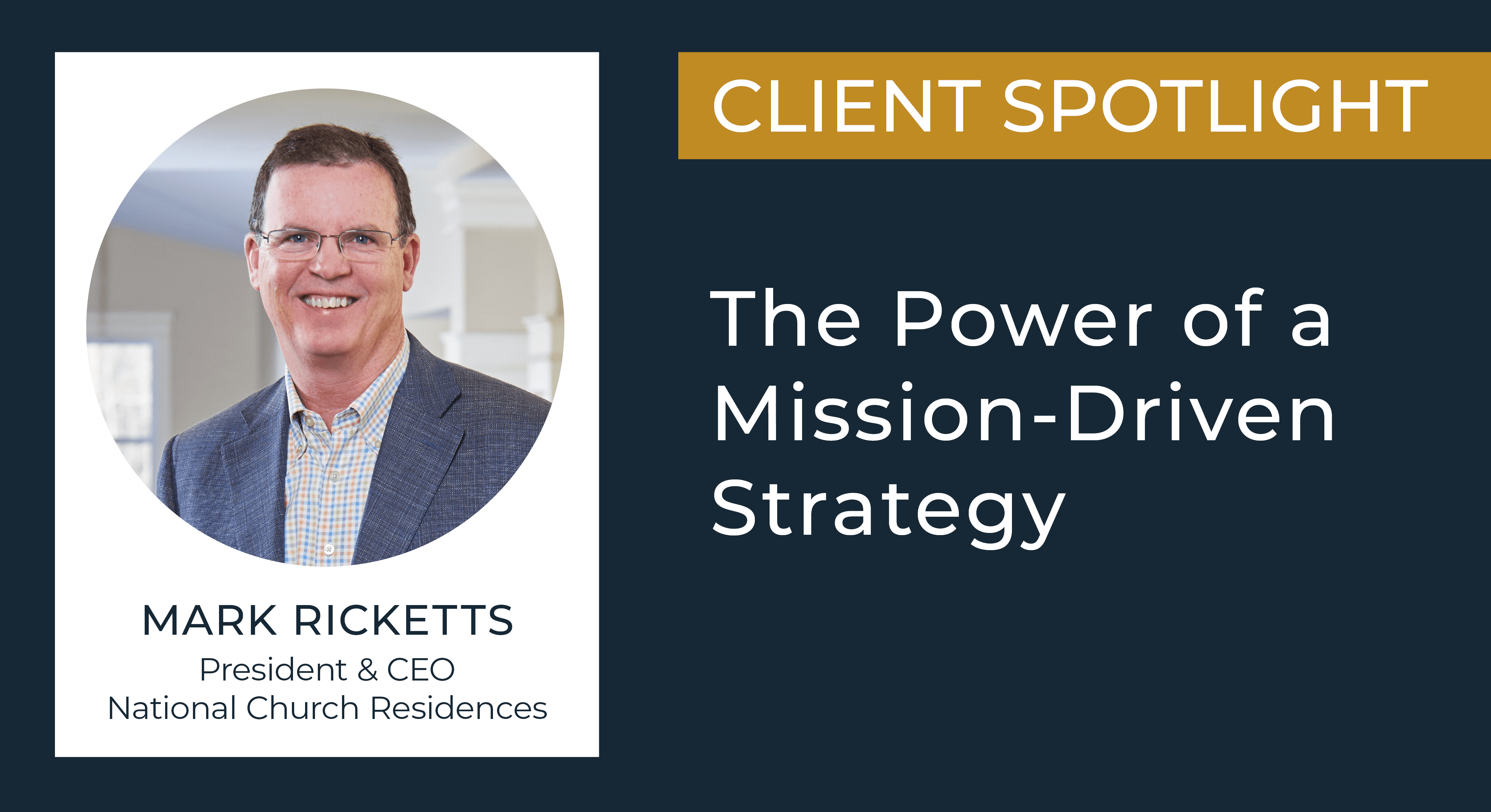Although not-for-profit National Church Residences has more than 340 communities in 25 states, its most enduring asset, the one that animates everything it does, is its faith-based mission. In 1961, the Rev. John R. Glenn the Presbyterian pastor of a small Ohio church, was deeply affected by the plight of older adults he encountered during his ministry. He was saddened to find that, all too often, they were lonely, excluded from the everyday joys of life, and humiliated because they were dependent on others.
Rather than simply bemoan their fate, Glenn acted. When FHA foreclosed on a campus of 400 unoccupied homes, Glenn saw a divinely inspired opportunity. He assembled a coalition of four local churches, placed the winning (and only) bid, and reimagined that subdivision as Bristol Village. Today, Bristol Village is a nationally recognized, 133-acre continuing care retirement community that has served tens of thousands of seniors over the decades.
“Although we’re a nondenominational organization, we were founded on a Christian commitment to ensure that all seniors, including those of modest means, benefit from comfortable housing and high-quality care services, enabling them to age with dignity and respect,” says Mark Ricketts, National Church Residences president and CEO. “Being part of that is such a privilege for all of us — as well as a source of competitive advantage.”
Ricketts found time in his schedule to talk to Lument about the role that the mission is playing in shaping the company’s strategy as it looks forward to meeting its goal of serving 100,000 seniors by 2030. Ricketts invited Sonya Brown, vice president of property management, Susan DiMickele, senior vice president of senior services and senior living, and Matthew Rule, senior vice president of housing development, to contribute to the discussion.
Lument: You’ve set some ambitious goals for 2030. What’s your starting point?
Mark Ricketts: Over the last 60 years, we’ve achieved mission scale and thus mission impact serving seniors in affordable housing. We’ve focused on senior living only during the past 15 years and on senior services for the past 10, so we have some catching up to do. To meet the growing needs of our older population, we recently developed a strategic plan focused on advancing better living for 100,000 seniors annually. This plan includes serving seniors not only living in our communities but also the ones who want to remain living in their homes. In order to accomplish this goal by 2030, we’ll focus on development and growth in three main areas – people, partnerships and performance.
Additionally, we’ll make strategic investments in expanding our affordable housing portfolio in core market areas, growing our senior services division and increasing our middle-market campus development.
At the same time, we are building out our senior living communities while retaining our emphasis on affordable housing for seniors. Matt and his team have adopted a geographic approach to development.
Matthew Rule: We know that, from a construction and operational point of view, having density in a market is really valuable to us. We will continue to embrace that model moving forward. For instance, in the Columbus MSA, where we’ve had a presence since we were founded, we have seven communities under construction. We are following a similar strategy in the Atlanta area, where we opened a regional office several years ago, and now we’re replicating this approach in the Austin-San Antonio corridor. We’re going deep into these marketplaces with the idea of being a consistent presence when people talk about affordable housing and senior living.
Lument: How has having a faith-based mission facilitated your expansion?
Mark Ricketts: One of the pillars of our strategic plan is partnerships, which can mean everything from affiliation to acquisition. Given our timeline, getting to mission scale means we can’t build everything — and we’ve found that being a faith-based, values-based organization resonates strongly with a select group of partners including certain sellers.
We’ve worked through several portfolio acquisitions this past year — we bought a portfolio of three buildings on the Christian City campus outside Atlanta and a portfolio of seven senior buildings from the Salvation Army in Texas. Both these organizations wanted to focus their energies elsewhere, but they didn’t want to see the mission end when they sold the property. They were looking for a buyer who would treat their residents well, a buyer who would continue to reinvest in their campuses. Because of our faith-based mission — and our record of living up to it — they were confident their residents were in good hands. One way of looking at these transactions is that they were placing their mission in our care.
Susan DiMickele: When family members consider where they want their loved ones to spend their last season of life, they want them to be cared for by someone who sees them as a whole person. This is true whether their loved ones choose to live at home or in one of our communities. And we feel that caring for the whole person means ministering to their spiritual needs as well as their physical and emotional ones. As part of our Christian commitment to service, we developed a chaplaincy program to provide our residents with ongoing spiritual support. Since the program started in 2018, it has grown to 80 volunteer chaplains serving 8,000 residents in affordable housing communities in four states, and we expect it will continue to expand year after year so we can better serve our residents.
Sonya Brown: For me, living the mission is all about people, about interacting with our residents. When I am out at a community, I get so much joy from those conversations, especially after we’ve completed a renovation or launched a new initiative, knowing I’ve made a difference.
The competition for people who want to work in affordable housing and senior living is intense, and one of the advantages National Church Residences has in recruiting new employees is that we can offer this level of fulfillment. This is my 18th year in the organization — and I can tell you that the connection we have with our residents has sustained me and continues to sustain me.
Mark Ricketts: I’d like to second what Sonya just said. Another pillar of our plan is people — and we’re focused intensely not just on filling vacancies but finding the right people to fill them. We want to make sure that we provide the right level of compensation, but there are more reasons to work for National Church Residences than pay and benefits. Generations coming up want to be purpose-driven in their work. It is such an advantage for us to say that when you work for us, you get to improve the quality of life for the seniors who have already contributed so much. We need to get the message out — and we need to do our best to make sure everyone in our organization shares this bond.
Lument: I think you can make the case that your consistent and compelling mission is the key to your longevity as an institution. How has that longevity contributed to your ability to expand?
Mark Ricketts: For 20 years, we had just one campus. When my predecessor, Tom Slemmer, became president and CEO, he saw in HUD’s Section 202 program, designed to encourage not-for-profits to build affordable housing for seniors, an opportunity for us to support more seniors. Each year, Tom filed more applications. Many of the communities were small, between 40 and 100 units, but it added up. When Tom retired, we had almost 20,000 units in 340 properties, 250 were financed with Section 202 funds.
As we all know, the funding model has changed completely. You can’t rely on a single window anymore, and we have to put up money for everything we do. The portfolio that Tom built has become quite valuable as a source of capital. When Matt applies for a grant, we have to prove we are creditworthy. Courageous and visionary leaders John Glenn and Tom Slemmer built that creditworthiness for us during that first 50 years.
Lument: As you’ve suggested, loans are now an important part of that financing stack. What are you looking for from a lender?
Mark Ricketts: This gets us back to the themes of partnership and people. A good test of a partner for me is whether we can form a friendship, one founded on trust, honesty and shared values. We work with Tracy Peters and his partners at Lument on so many of our projects because we know they will do right by us.
Matthew Rule: One of the things that has impressed us about Lument is that they have done a great job understanding our business model. Tracy comes to our board meetings, connects with our team, and is always learning about our organization. An acquisition with a faith-based organization might take two years, and Lument adjusts to that pace because they understand the dynamics of our market. We also appreciate that the leadership of the finance team is engaged at the transactional level. That’s unique in our experience.
Lument: Looking ahead, what’s your sense of the future of affordable housing?
Mark Ricketts: It’s true that there is a convergence of challenges confronting our industry right now — supply chain issues, higher construction and labor costs, and rising interest rates. But I think there is a lot to be optimistic about. I have been in the affordable housing industry throughout my career, and civic leaders and the government are paying more attention than I’ve ever seen before on affordable housing. That’s encouraging.

